| ________________
CM . . .
. Volume XVIII Number 13. . . .November 25, 2011 
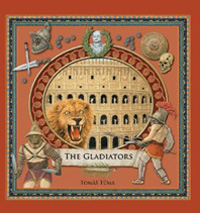 |
The Gladiators. (Shapes Books Series).
Tomáš Tuma.
Richmond Hill, ON: Firefly Books, 2011.
30 die-cut board pages, self-boxed board book, $16.95.
ISBN 978-1-55407-932-2.
Subject Headings:
Gladiators-Juvenile literature.
Rome-Civilization-Juvenile literature.
Board Books.
Grades 3-5 / Ages 8-10.
Review by Gail Hamilton.
***½ /4
|
| |
|
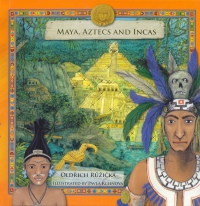 |
Maya, Aztecs and Incas. (Shapes Books Series).
Oldrich Ruñica. Illustrated by Pavla Kleinová.
Richmond Hill, ON: Firefly Books, 2011.
30 die-cut board pages, self-boxed board book, $16.95.
ISBN 978-1-55407-933-9.
Subject Headings:
Mayas-Juvenile literature.
Incas-Juvenile literature.
Aztecs-Juvenile literature.
Grades 3-5 / Ages 8-10.
Review by Gail Hamilton.
***½ /4
|
| |
|
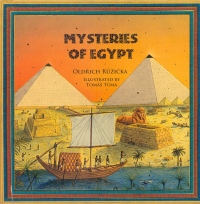 |
Mysteries of Egypt. (Shapes Books Series).
Oldrich Ruńica. Illustrated by Tomáš Tuma.
Richmond Hill, ON: Firefly Books, 2011.
30 die-cut board pages, self-boxed board book, $16.95.
ISBN 978-1-55407-934-6.
Subject Heading:
Egypt-Civilization-To 332 BC-Juvenile literature.
Grades 3-5 / Ages 8-10.
Review by Gail Hamilton.
***½ /4
|
| |
|

excerpt:
Atahuallpa offered to fill a room the size of his cell with gold in exchange for his freedom. The Spanish agreed to the exchange, and a room 20 feet (6 m) long by 16 feet (5 m) wide was gradually filled with gold for the Spanish.
However, Atahuallpa was executed before the room was filled completely. Some believe that the last and largest part of the gold never arrived at the prison. When word of Atahuallpa's death came, the Inca hid the gold in the mountains. This extraordinary collection of Inca treasure thereby vanished forever. (From Maya, Aztecs and Incas.)
These intriguing self-boxed three dimensional board books are part of the new "Shape Books Series." Though the concept of a shaped board book is not new, the idea of presenting a bit of history in this format is definitely unique. Once the reader opens the cover/box, an iconic structure from a particular civilization will be revealed. The 3-D structure has been "sliced" into layers creating pages upon which the text and illustrations appear.
 Pages in The Gladiators form the oval shape of the Roman Colosseum. In ancient Rome, gladiators were mostly slaves or prisoners of war whose fight training took place at gladiatorial schools. This title provides a brief history of ancient Rome, a description of the architectural features and sections of the Colosseum, and information about the life of a gladiator. Readers will learn that there were different types of gladiators based on their weapons of choice, and even gladiators who specialized in fighting against wild animals, such as bears and lions, with elaborate painted sceneries of wild animals as backdrops for the fights. These backdrops came up from the arena floor using the underground elevator system. Sometimes the Colosseum was filled with water so that audiences could watch sea battles. There are illustrations depicting the many types of weapons and protective equipment used by gladiators. Some examples of weapons include the pugio (dagger), the sica (sword) and the trident. Pages in The Gladiators form the oval shape of the Roman Colosseum. In ancient Rome, gladiators were mostly slaves or prisoners of war whose fight training took place at gladiatorial schools. This title provides a brief history of ancient Rome, a description of the architectural features and sections of the Colosseum, and information about the life of a gladiator. Readers will learn that there were different types of gladiators based on their weapons of choice, and even gladiators who specialized in fighting against wild animals, such as bears and lions, with elaborate painted sceneries of wild animals as backdrops for the fights. These backdrops came up from the arena floor using the underground elevator system. Sometimes the Colosseum was filled with water so that audiences could watch sea battles. There are illustrations depicting the many types of weapons and protective equipment used by gladiators. Some examples of weapons include the pugio (dagger), the sica (sword) and the trident.
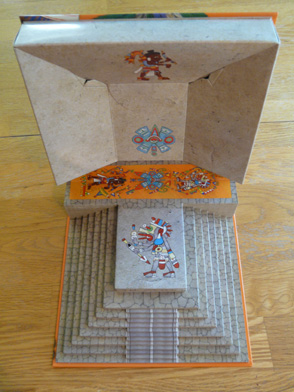 The shape of the pages in Maya, Aztecs and Incas is that of a flat-topped pyramid or temple. In this title, readers will find out where and how each of the featured groups lived and what contributions they made to modern civilization. The Mayans settled in the Yucatan peninsula of Mexico. They were gifted mathematicians and astronomers and devised a written language using glyphs. One of their contributions to the world was chocolate, and so the author has included a recipe for hot chocolate that is slightly different than what readers are used to- it contains chili peppers, almonds, vanilla pods, honey and cinnamon in addition to dark chocolate and milk. The Aztecs built huge pyramids to honour their gods. Like the Mayans, they had their own calendar. Some of the topics related to Aztecs include the various gods whom they worshipped, human sacrifices, warriors and their weapons, and the sacred ball game. In the portion of the book devoted to Incas, readers will learn that the Incan people were masters of working with gold, developed a system of roads to deliver messages, and built the city of Machu Picchu which was rediscovered in the 20th century and is an example of the Incas' excellent stonework.
The shape of the pages in Maya, Aztecs and Incas is that of a flat-topped pyramid or temple. In this title, readers will find out where and how each of the featured groups lived and what contributions they made to modern civilization. The Mayans settled in the Yucatan peninsula of Mexico. They were gifted mathematicians and astronomers and devised a written language using glyphs. One of their contributions to the world was chocolate, and so the author has included a recipe for hot chocolate that is slightly different than what readers are used to- it contains chili peppers, almonds, vanilla pods, honey and cinnamon in addition to dark chocolate and milk. The Aztecs built huge pyramids to honour their gods. Like the Mayans, they had their own calendar. Some of the topics related to Aztecs include the various gods whom they worshipped, human sacrifices, warriors and their weapons, and the sacred ball game. In the portion of the book devoted to Incas, readers will learn that the Incan people were masters of working with gold, developed a system of roads to deliver messages, and built the city of Machu Picchu which was rediscovered in the 20th century and is an example of the Incas' excellent stonework.
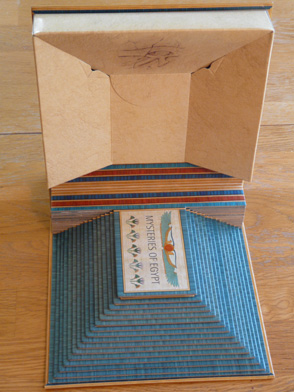 Mysteries of Egypt, predictably, is in the form of a pyramid. This title focuses on the importance of the Nile River to ancient Egyptians, famous pharaohs and their symbols, gods and goddesses, papyrus and hieroglyphic writing, and architectural structures and details, such as pyramids and obelisks. Other topics include mummification, the discovery of King Tut's tomb (and the subsequent mummy's curse), pyramid construction, and the four monuments of the Giza Plateau: Khufu's Great Pyramid, the Pyramid of Khafra, the Pyramid of Menkaura and the Great Sphinx. There are cross-sections of pyramids as well as diagrams of the three different types of pyramids built in ancient Egypt.
Mysteries of Egypt, predictably, is in the form of a pyramid. This title focuses on the importance of the Nile River to ancient Egyptians, famous pharaohs and their symbols, gods and goddesses, papyrus and hieroglyphic writing, and architectural structures and details, such as pyramids and obelisks. Other topics include mummification, the discovery of King Tut's tomb (and the subsequent mummy's curse), pyramid construction, and the four monuments of the Giza Plateau: Khufu's Great Pyramid, the Pyramid of Khafra, the Pyramid of Menkaura and the Great Sphinx. There are cross-sections of pyramids as well as diagrams of the three different types of pyramids built in ancient Egypt.
The text provides just enough information and affords readers a glimpse into some of the world's most significant ancient empires. Illustrations- drawings, diagrams and maps- on sepia-toned backgrounds complement the text, while wide bands along the gutter of the page depict colourful motifs specific to the ancient culture, adding the perfect finishing touch.
These titles will prove to be very popular due to their unique and novel quality. Although the books are durable, it is difficult to predict whether they will be able to withstand the wear and tear of frequent check-outs from a public or school library. Perhaps they are best reserved for gift-giving, and lucky recipients of any one of the titles will find it to be informative and highly engaging.
Highly appealing and educational with a clever twist.
Highly Recommended.
Gail Hamilton is a former teacher-librarian in Winnipeg, MB.

To comment
on this title or this review, send mail to cm@umanitoba.ca.
Copyright © the Manitoba Library Association. Reproduction for personal
use is permitted only if this copyright notice is maintained. Any
other reproduction is prohibited without permission.
NEXT REVIEW |
TABLE OF CONTENTS FOR THIS ISSUE
- November 25, 2011.
AUTHORS |
TITLES |
MEDIA REVIEWS |
PROFILES |
BACK ISSUES |
SEARCH |
CMARCHIVE |
HOME |



 Pages in The Gladiators form the oval shape of the Roman Colosseum. In ancient Rome, gladiators were mostly slaves or prisoners of war whose fight training took place at gladiatorial schools. This title provides a brief history of ancient Rome, a description of the architectural features and sections of the Colosseum, and information about the life of a gladiator. Readers will learn that there were different types of gladiators based on their weapons of choice, and even gladiators who specialized in fighting against wild animals, such as bears and lions, with elaborate painted sceneries of wild animals as backdrops for the fights. These backdrops came up from the arena floor using the underground elevator system. Sometimes the Colosseum was filled with water so that audiences could watch sea battles. There are illustrations depicting the many types of weapons and protective equipment used by gladiators. Some examples of weapons include the pugio (dagger), the sica (sword) and the trident.
Pages in The Gladiators form the oval shape of the Roman Colosseum. In ancient Rome, gladiators were mostly slaves or prisoners of war whose fight training took place at gladiatorial schools. This title provides a brief history of ancient Rome, a description of the architectural features and sections of the Colosseum, and information about the life of a gladiator. Readers will learn that there were different types of gladiators based on their weapons of choice, and even gladiators who specialized in fighting against wild animals, such as bears and lions, with elaborate painted sceneries of wild animals as backdrops for the fights. These backdrops came up from the arena floor using the underground elevator system. Sometimes the Colosseum was filled with water so that audiences could watch sea battles. There are illustrations depicting the many types of weapons and protective equipment used by gladiators. Some examples of weapons include the pugio (dagger), the sica (sword) and the trident.